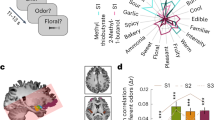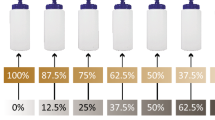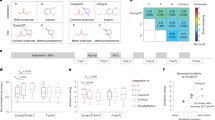Abstract
OLFACTORY signals must be coded both externally and internally. Externally, the odorous molecules present distinctive patterns based on their ability to excite several more or less widely separated intervals in a linear continuum of osmic stimuli1,2. In other words, each odorous molecule carries a characteristic combination of primary stimuli. Internally, the characteristic pattern of the stimulus molecules must be transformed into a patterned neural discharge which somehow reflects the specificity of the input signal from the odorous molecules. To solve the olfactory code, we must find a correlation between physically observable properties of the external stimulus and the internal response.
This is a preview of subscription content, access via your institution
Access options
Subscribe to this journal
Receive 51 print issues and online access
$199.00 per year
only $3.90 per issue
Buy this article
- Purchase on Springer Link
- Instant access to full article PDF
Prices may be subject to local taxes which are calculated during checkout
Similar content being viewed by others
References
Wright, K. H., Canad. Entomologist, 98, 1083 (1966).
Wright, R. H., Proc. NATO Symp. on Theories and Measurement of Odor, Istanbul, 1966 (in the press).
Wright, R. H., Ann. NY Acad. Sci., 116, 552 (1964).
Wright, R. H., Nature, 209, 571 (1966).
Wright, R. H., Perf. Essent. Oil Record (in the press).
Gesteland, R. C., Lettvin, J. Y., Pitts, W. H., and Rojas, A., Proc. First Intern. Symp. Olfaction and Taste, Stockholm, 1962 (Macmillan, 1963).
Allison, A. C., and Warwick, R. T. T., Brain, 72, 186 (1949).
Le Gros Clark, W. E., Proc. Roy. Soc., B, 146, 299 (1957).
Hughes, J. R., and Hendrix, D. E., Proc. Second Intern. Symp. Olfaction and Taste, Tokyo, 1965 (Pergamon, 1967).
Hughes, J. R., and Hendrix, D. E., Proc. NATO Symp. on Theories and Measurement of Odor, Istanbul, 1966 (in the press).
Demerdache, A., and Wright, R. H., Proc. Second Intern. Symp. Olfaction and Taste, Tokyo, 1965 (Pergamon, 1967).
Wright, R. H., Nature, 209, 551 (1966).
Author information
Authors and Affiliations
Rights and permissions
About this article
Cite this article
WRIGHT, R., HUGHES, J. & HENDRIX, D. Olfactory Coding. Nature 216, 404–406 (1967). https://doi.org/10.1038/216404a0
Received:
Revised:
Published:
Issue Date:
DOI: https://doi.org/10.1038/216404a0
This article is cited by
Comments
By submitting a comment you agree to abide by our Terms and Community Guidelines. If you find something abusive or that does not comply with our terms or guidelines please flag it as inappropriate.



